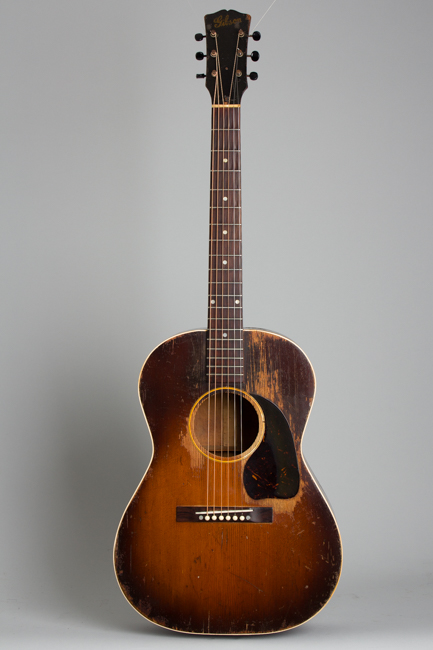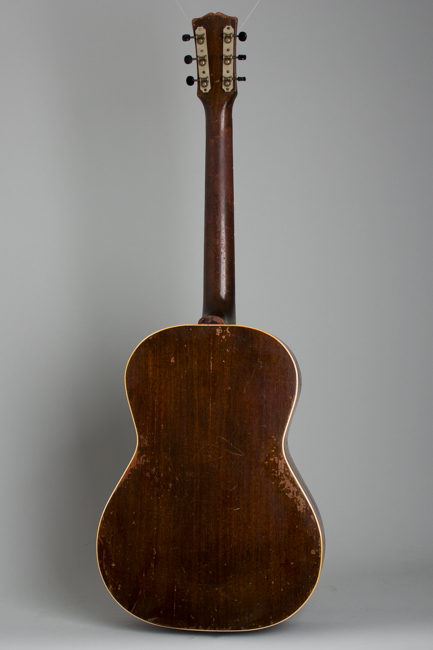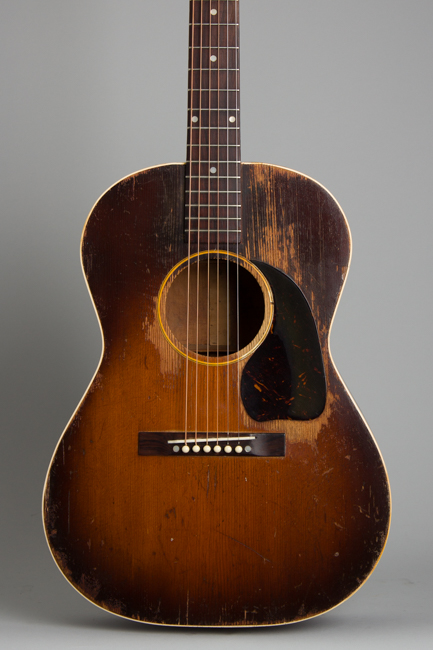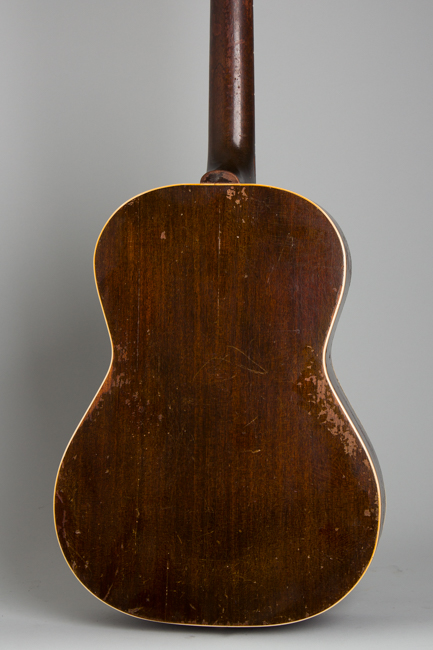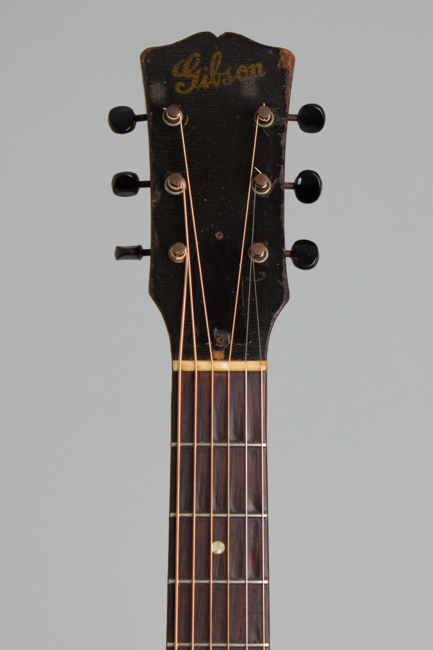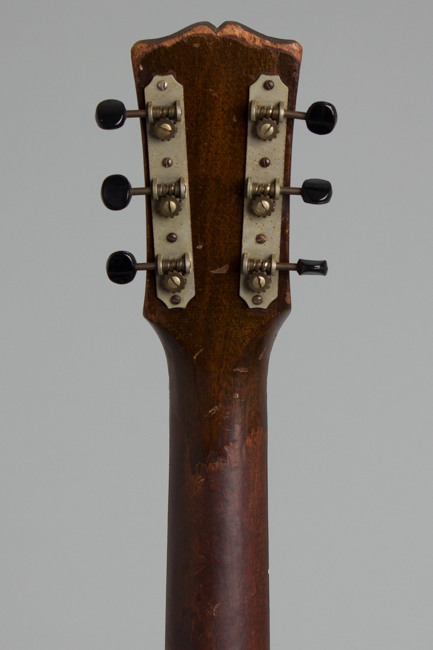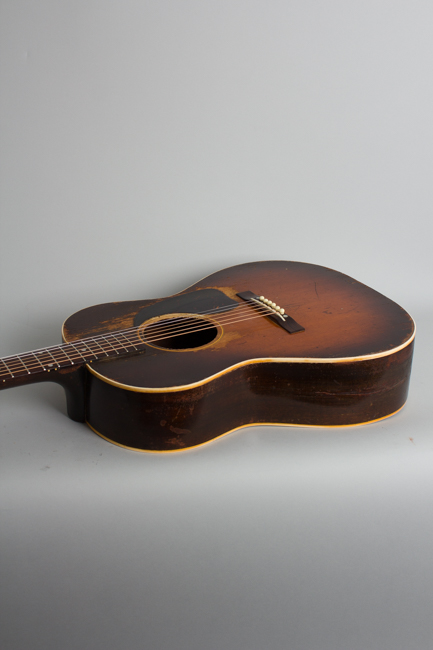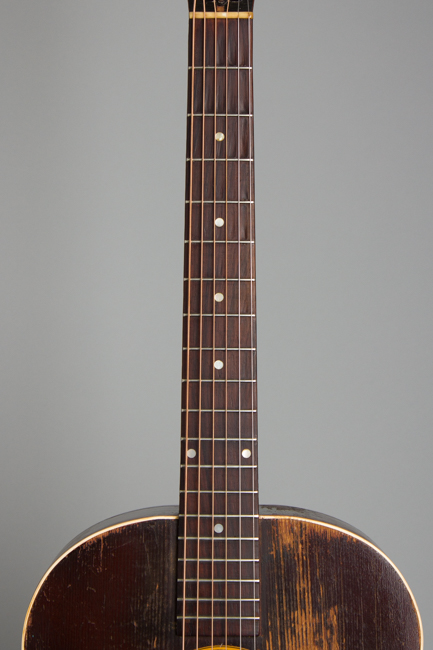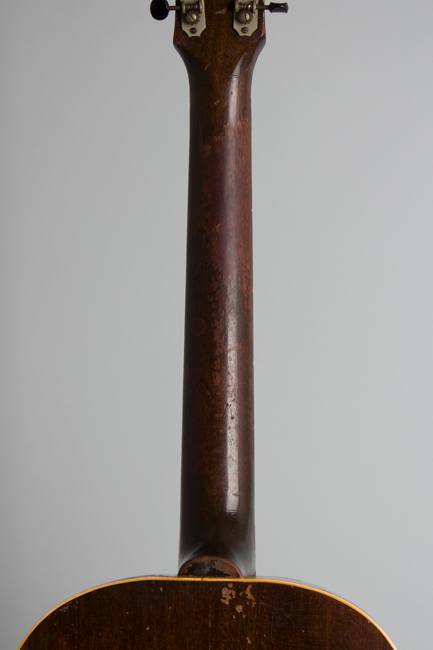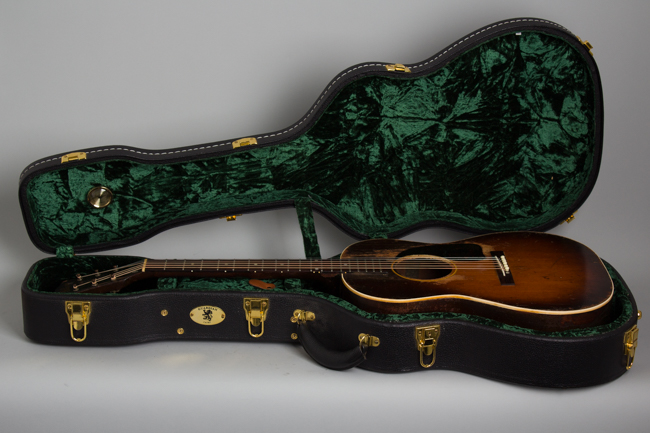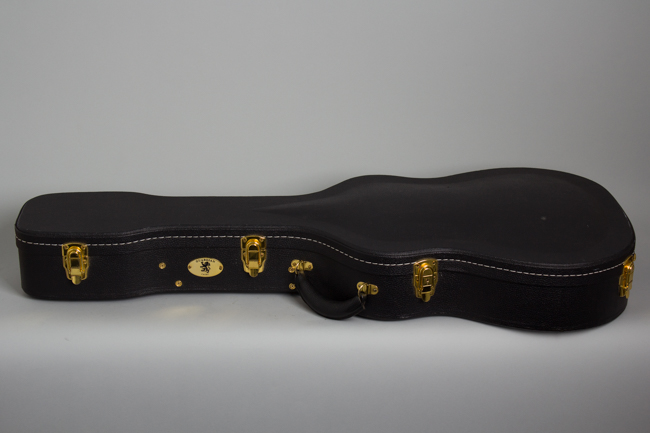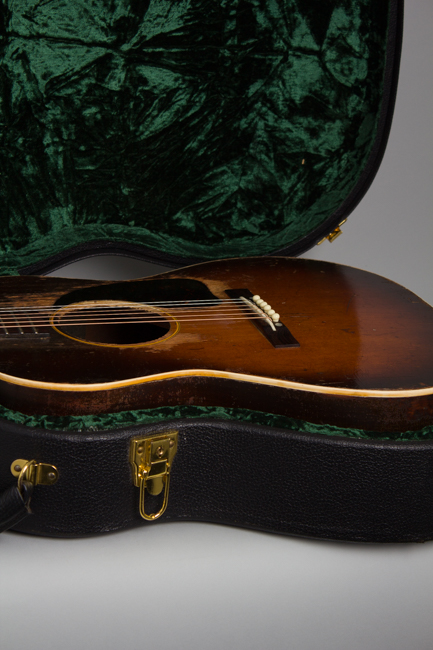Gibson LG-2 Flat Top Acoustic Guitar (1946)
This item has been sold.
Item # 11000
Prices subject to change without notice.
Gibson LG-2 Model Flat Top Acoustic Guitar (1946), made in Kalamazoo, Michigan, sunburst top, dark stained back and sides finish, mahogany back, sides and neck, spruce top, rosewood fingerboard, black tolex hard shell case.
This is a REALLY heavily played early post-WWII Gibson LG-2, and giving it one strum it's easy to see why! This model was Gibson's most popular smaller body flat-top guitar model from the 1940s and '50s. It occupied the middle position in a three-instrument line with the externally identical but ladder braced LG-1 below it and the natural-finish LG-3 above. Exact production figures from this period are lost, but in 1948-50 the LG-2 sold roughly 1000 instruments a year, with more than double that amount of LG-1's shipped. The first post-war ones like this are somewhat scarcer, suggesting they were built in smaller numbers as Gibson was just getting back up to speed after doing mostly war work for 4 years.
These 1946-47 guitars have no serial or factory order numbers but can be easily identified by their gold script headstock logo, a holdover from the war years. This was a short-lived transitional feature before the later block script "modern" logo appeared in 1948. Other typical features include a deep sunburst top finish, small tortoise celluloid pickguard, small rectangle bridge, triple-bound top and single-bound back.
The headstock bears the gold script "Gibson" logo and is tapered in depth, with just-postwar Kluson strip tuners fitted. The truss-rod equipped neck has a lovely round-backed "C" profile, rather slimmer than the thick wartime "baseball bat" style and very comfortable. This is a truly great sounding and versatile guitar; its many scars are well-earned and even as a "genuine relic" worn this heavily it is a fine example of Gibson's great post-war flat-top period.
Overall length is 39 1/2 in. (100.3 cm.), 14 3/8 in. (36.5 cm.) wide at lower bout, and 4 1/2 in. (11.4 cm.) in depth at side, taken at the end block. Scale length is 24 3/4 in. (629 mm.). Width of nut is 1 11/16 in. (43 mm.).
This is an obviously well worn, very heavily loved and played instrument, and boy does it sound like it! There is wear practically everywhere; the finish is heavily checked and the top has been subjected to some very enthusiastic strumming over the last 75 or so years. There is deep pickwear into the wood all around the pickguard and soundhole, though nothing is into Willie Nelson territory yet. The rest of the instrument has a varied collection of scratches, scuffs, nicks and dings almost everywhere. The back of the neck is heavily worn down to the wood, with feelable soft dinks along the spine to the area of finish remaining above the 5th fret.
As might be expected the instrument shows a number of repairs, well done and completely solid but in some cases visible. There are fewer repairs to the top than one might expect, just a couple of very thin tight grain cracks just below the front edge of the pickguard. The back has had the upper center seam resealed and another thin grain split near the lower waist. The sides have seen the most work. There is a repaired crack just above the back/edge seam running from the upper side of the heel to the edge of the upper bass bout, and a several splits on the curve of the lower bass bout that have bad some minor overfinishing.
There has been some internal work; the rear legs of the main X braces appear to have been scalloped lightly post facto, a nicely done job without making them too thin. The small maple bridge plate is a very nicely done reproduction. The bridge appears original but lowered somewhat and re-attached long ago; the retaining bolts are still in place. The neck has been reset and although the frets are period correct we must assume this is an older refret due to the amount of wear on the fingerboard. While this guitar has seen more than its share of wear and repair it remains simply a wonderful instrument to play; sweet and powerful sounding with a ringing tone that belies its small size. It is what we like to call a "Genuine relic' in an era of ersatz ones, "Ragged but Right" as we say in honor of Riley Puckett. It is housed in a more recent HSC. Very Good + Condition.
This is a REALLY heavily played early post-WWII Gibson LG-2, and giving it one strum it's easy to see why! This model was Gibson's most popular smaller body flat-top guitar model from the 1940s and '50s. It occupied the middle position in a three-instrument line with the externally identical but ladder braced LG-1 below it and the natural-finish LG-3 above. Exact production figures from this period are lost, but in 1948-50 the LG-2 sold roughly 1000 instruments a year, with more than double that amount of LG-1's shipped. The first post-war ones like this are somewhat scarcer, suggesting they were built in smaller numbers as Gibson was just getting back up to speed after doing mostly war work for 4 years.
These 1946-47 guitars have no serial or factory order numbers but can be easily identified by their gold script headstock logo, a holdover from the war years. This was a short-lived transitional feature before the later block script "modern" logo appeared in 1948. Other typical features include a deep sunburst top finish, small tortoise celluloid pickguard, small rectangle bridge, triple-bound top and single-bound back.
The headstock bears the gold script "Gibson" logo and is tapered in depth, with just-postwar Kluson strip tuners fitted. The truss-rod equipped neck has a lovely round-backed "C" profile, rather slimmer than the thick wartime "baseball bat" style and very comfortable. This is a truly great sounding and versatile guitar; its many scars are well-earned and even as a "genuine relic" worn this heavily it is a fine example of Gibson's great post-war flat-top period.
Overall length is 39 1/2 in. (100.3 cm.), 14 3/8 in. (36.5 cm.) wide at lower bout, and 4 1/2 in. (11.4 cm.) in depth at side, taken at the end block. Scale length is 24 3/4 in. (629 mm.). Width of nut is 1 11/16 in. (43 mm.).
This is an obviously well worn, very heavily loved and played instrument, and boy does it sound like it! There is wear practically everywhere; the finish is heavily checked and the top has been subjected to some very enthusiastic strumming over the last 75 or so years. There is deep pickwear into the wood all around the pickguard and soundhole, though nothing is into Willie Nelson territory yet. The rest of the instrument has a varied collection of scratches, scuffs, nicks and dings almost everywhere. The back of the neck is heavily worn down to the wood, with feelable soft dinks along the spine to the area of finish remaining above the 5th fret.
As might be expected the instrument shows a number of repairs, well done and completely solid but in some cases visible. There are fewer repairs to the top than one might expect, just a couple of very thin tight grain cracks just below the front edge of the pickguard. The back has had the upper center seam resealed and another thin grain split near the lower waist. The sides have seen the most work. There is a repaired crack just above the back/edge seam running from the upper side of the heel to the edge of the upper bass bout, and a several splits on the curve of the lower bass bout that have bad some minor overfinishing.
There has been some internal work; the rear legs of the main X braces appear to have been scalloped lightly post facto, a nicely done job without making them too thin. The small maple bridge plate is a very nicely done reproduction. The bridge appears original but lowered somewhat and re-attached long ago; the retaining bolts are still in place. The neck has been reset and although the frets are period correct we must assume this is an older refret due to the amount of wear on the fingerboard. While this guitar has seen more than its share of wear and repair it remains simply a wonderful instrument to play; sweet and powerful sounding with a ringing tone that belies its small size. It is what we like to call a "Genuine relic' in an era of ersatz ones, "Ragged but Right" as we say in honor of Riley Puckett. It is housed in a more recent HSC. Very Good + Condition.
